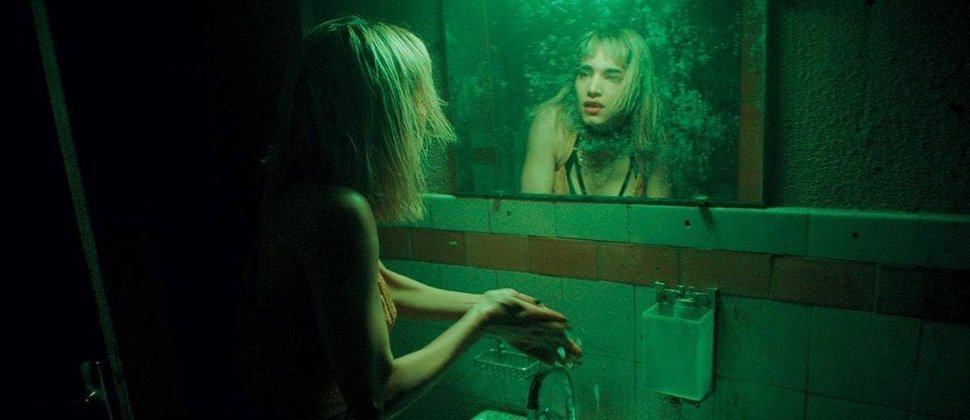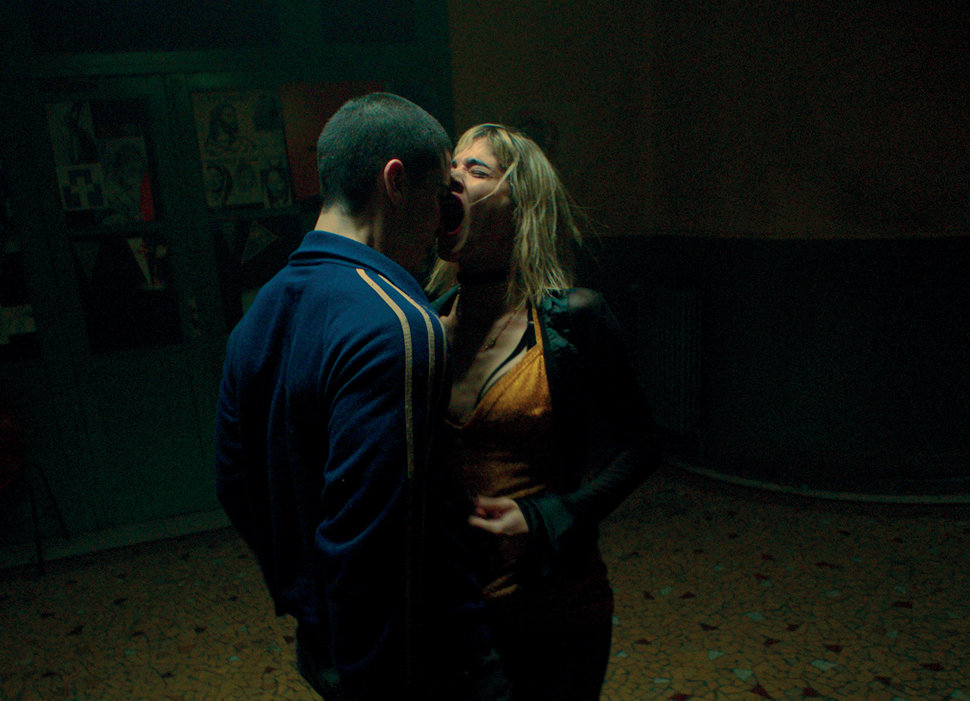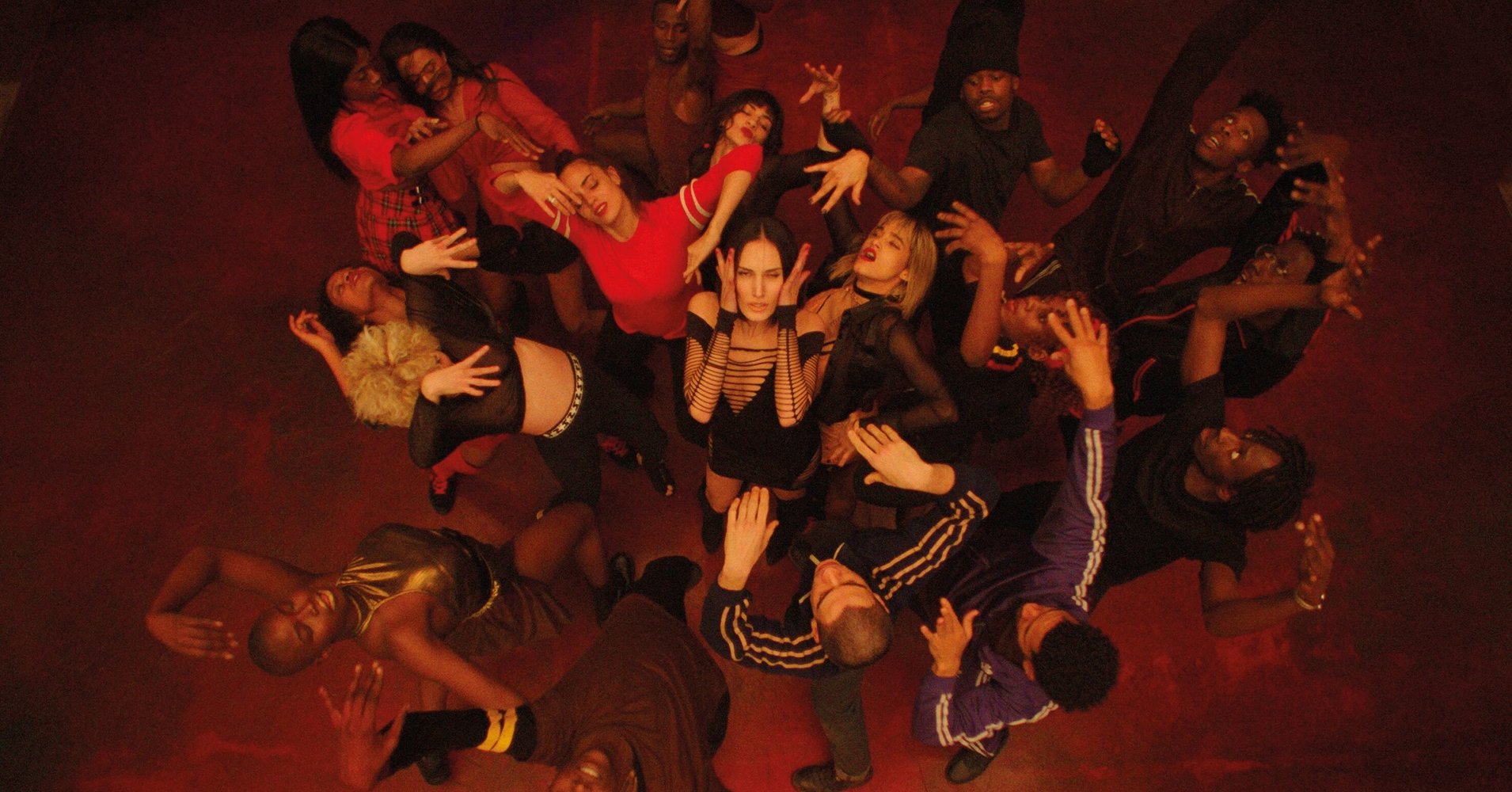[ad_1]
Some two dozen dancers gather at a remote schoolhouse in France. Outside, snowfall casts an apocalyptic chill; inside, sweat is dripping and bodies are convulsing to a throbbing disco surge. “God is with us,” the troupe’s choreographer howls as they engage in an orgy of the senses. It’s their last rehearsal before touring the United States and beyond — if, that is, they survive the night. The sangria they down after finishing the run-through is spiked with LSD, much to everyone’s shock, and what began as a free-spirited celebration ends with blood, blame, battery, incest and other hallucinatory hazards.
So it goes in “Climax,” the 95-minute horror bacchanalia that exists in the hallowed space between must-see and can’t-watch. That’s familiar territory for director Gaspar Noé (“Irréversible,” “Enter the Void”), an extremist whose work flirts with nihilism. Here, he serves up maybe 40 minutes of ecstasy, duping us into thinking he’s made something joyful before swerving to a fevered agony that’s as exhilarating as it is disturbing. This is not a film for everyone, and that’s precisely why it’s incredible. When I saw it for a third time in Brooklyn last week, the woman sitting next to me was holding her head and moaning during the final half hour.
“It’s like you start with a roller coaster going up, up, up, and suddenly the roller coaster starts going down,” Noé said by phone. “Any spectator that sees the movie knows it’s just an imitation of life.”
However bleak, he’s not wrong. As the opening credits imply, Noé based “Climax” on a news story from the ’90s in which French dancers found their drinks laced with acid. He wouldn’t tell me whether things ended as brutally for them as they do for his characters, but there’s a certain catharsis in seeing such highs ― pun intended ― butt up against such diabolical lows.

What’s most impressive about “Climax” is how it was made. In December 2017, Noé attended a voguing ball where he was inspired to pursue a project about dancers of varying races, nationalities and sexual identities who come together with a carnal, catty joie de vivre. In lieu of a proper script, he wrote a short treatment that introduced the characters and outlined the story in only the broadest strokes. Everything else was fleshed out during the shoot, which spanned a quick 15 days, with Noé operating the camera himself. By the following May, “Climax” was already premiering at the Cannes Film Festival.
Initially, Noé envisioned the movie as two halves: before the acid and after the acid ― both shot to look like continuous 40-minute takes, with the credits sandwiched in the middle. That’s what Sofia Boutella signed on for when Noé sent her an Instagram message asking if she’d play the choreographer, Selva, who doubles as the de facto protagonist.
Casting Boutella, who toured with Madonna before starring in “The Mummy” and “Atomic Blonde,” changed the game. Noé wasn’t planning to hire an actual choreographer to put together the vibrant dance number that opens “Climax,” but Boutella insisted he’d need a professional to wrangle 20-some performers. She recommended Nina McNeely, who has worked with Christina Aguilera, Rihanna and Banks. By then, everything was moving quickly: After deciding on the song ― Cerrone’s “Supernature” ― McNeely had only one day to prep and two days to rehearse the complex ensemble, whose free-flowing buffet of styles create what she calls “structured improvisation.”

On the next day, Noé brought her a few more dancers to add in and shot the scene as one roving take, the camera floating around and drifting overhead: Busby Berkeley on shrooms. There are voguers and krumpers and waackers and duck-walkers and electro hoofers and Shiva arms and catwalking, all bobbing around one other in a hodgepodge of ’90s euphoria. McNeely took inspiration from “A Chorus Line,” “Sweet Charity” (and all things Bob Fosse), Pina Bausch and Federico Fellini. It’s enough to make you assume the rest of “Climax” will be festive too.
“They are very charismatic, very sexy, very young, and especially their dancing skills and the language they invent with their bodies is so incredible that as a spectator you are envious of them,” Noé said. “You are curious about being part of that group because they kind of celebrate life in a conscious way. I could have done a whole movie like that, but I don’t think that happy endings make happy spectators.”
So Noé and company turned the back half of “Climax” into a nightmare. The after-party starts off pleasantly enough, with petty jealousies and horny desires undergirding the dancers’ boozy interactions. Noé beaks up the two halves with mini-conversations about marriage, sex, cocaine and other indiscretions, all shot in close-up and spliced together in rapid succession with music throbbing in the background. But when the LSD kicks in, the pulse shifts to a minor key and Selva becomes a tour guide for the frenzy. The camera follows her through a neon-green hallway, in and out of rooms where people fight or hook up or freak out. Eventually, she wanders back to the cavernous rehearsal den, where a mother tends to her preschooler, a pregnant woman wields a knife, a suspected traitor gets tossed into the snowstorm, and others become hypnotized by their own movements.
McNeely was key during that long sequence, too. She would follow Noé and Boutella, hollering “obscenities” (read: stage directions). “I’d be like, ‘Look at the curtain! Throw your body on the floor! Kick the wall screaming,’” McNeely explained. “Sofia only did some of the things I said, so it’s really funny because I just seem like a fucking insane person screaming random things.”

It worked, though. We can see the experience mounting in Boutella’s eyes, and the way Noé’s camera swirls in relation to the proceedings makes us feel like ghosts following her into hell. That long green hallway? There might as well be a sign that reads “Abandon all hope, ye who enter here.” Or, as the Yeah Yeah Yeahs once sang, “Dance, dance, dance till you’re dead.”
Boutella based her performance in part off Andrzej Żuławski’s psychological thriller “Possession,” specifically a scene in which the main character, played by Isabelle Adjani, flails her body around during a manic meltdown in a subway station. Boutella had never taken hallucinogens, and in fact McNeely became a sort of acid muse for most of the actors on the set, dictating how the drug would affect each person differently.
Because she didn’t know what a physical experience LSD is, Boutella underestimated how demanding the film would be. She shot eight- to 10-minute chunks at a time, over and over, wailing and writhing in an abandoned boys’ school outside Paris. At one point, Selva thrusts her hands into her tights, only to peer down and think they’re stuck there permanently, after which she thrashes around like a dervish. It’s at once hilarious and unsettling, and a master class in acting.
“I knew at the moment he gave me the role of the choreographer, he wanted this choreographer [to be someone who] who never got the chance to dance the way she probably wanted to,” Boutella said. “She got to this point and she’s older than everybody, and she’s trying to unify and bring everybody together. I wanted to find some color because the moment I’m completely high I wanted the worst part of her to come out. It’s the true part of her that she never shows to anybody, some sort of darkness.”
By the time “Climax” ends, that darkness is king. There’s no going back, as if everyone involved has reached some sort of feral nadir. It recalls the gruesome opera that closed last year’s “Suspiria” remake, which is fitting because the original “Suspiria” is name-checked in “Climax.” Some of the final moments are filmed upside down in a haze of reds and blacks that offer an unintelligible violence, leaving audiences gasping for air.
Of course, Noé thinks the whole descent is hilarious. At times, he’s right, as when Selva sees herself in a mirror and leaps back in horror. But there’s also a prevailing sense of despair, scored by the likes of Giorgio Moroder and Aphex Twin. Life, “Climax” seems to say, opens the door for infinite possibilities, only to reveal crushing terrors, sometimes in the same night. One can only hope that, when all is said and done, you’ll still be dancing.
“It is, in many ways, a positive movie,” Noé said. “It’s dark in an educational way, but the more you think about it, the more you have a kind of vision for what human cruelty is. We are talking about some subjects that make you see the shadow; it shows cruelty out of the light of the sun. You are happy to see these horrors onscreen that you haven’t seen in real like, like when you have a nightmare. … It is helpful to see all those fears inside your mind while you’re sleeping or when you enter a movie theater. People still, at the end of the movie, keep their joy of the first part of the movie. Many people say, ‘Oh, this was a ride, but I enjoyed it.’”
“Climax” is now in theaters.
[ad_2]
Source link

